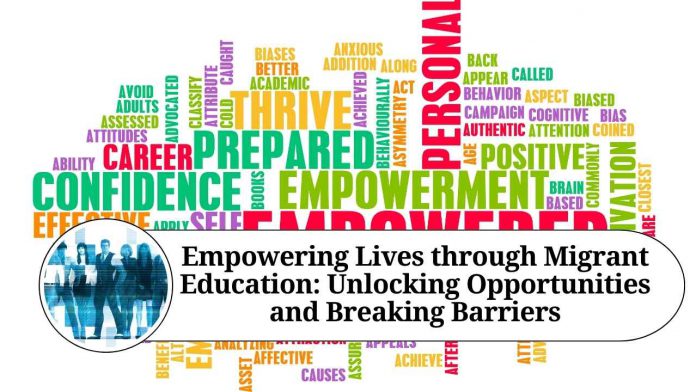Introduction:
In an increasingly interconnected world, migration has become a prevalent phenomenon. People move from one place to another, often seeking better economic prospects, escaping conflict, or pursuing educational opportunities. Amongst these migrants, there is a significant population of children and young adults whose educational journey is disrupted due to frequent relocations. Ensuring access to quality education for migrant populations is not only a matter of social justice but also a means of empowering individuals and contributing to the overall development of society. In this blog, we will explore the challenges faced by migrant students and highlight the importance of migrant education in unlocking opportunities and breaking barriers.
Challenges Faced by Migrant Students:
Migrant students encounter a multitude of obstacles on their educational path, which can significantly impede their learning and development. Some of the key challenges include:
- Limited Access to Education: Migrant students often face barriers in accessing education due to various reasons such as language barriers, lack of documentation, and unfamiliarity with the education system in the host country. This lack of access further widens the educational attainment gap.
- Educational Discontinuity: Frequent relocations disrupt the continuity of education for migrant students. They may experience gaps in their learning, as different regions or countries may follow different curricula and educational standards. This discontinuity can lead to learning delays and difficulties in integration.
- Language and Cultural Barriers: Language differences pose significant challenges for migrant students, particularly when they are required to learn and adapt to a new language. Additionally, cultural differences can create a sense of alienation, making it harder for them to adjust to their new educational environment.
- Socio-economic Factors: Migrant families often face socio-economic hardships, which can impact a child’s educational prospects. Limited financial resources, lack of stable housing, and inadequate support systems can hinder their ability to thrive academically.
Importance of Migrant Education:
Migrant education plays a crucial role in addressing the unique needs of migrant students and fostering their overall development. Here are some reasons why migrant education is of utmost importance:
- Equal Opportunity: Education is a fundamental right, and every child, regardless of their migratory status, should have equal access to quality education. Migrant education ensures that children do not miss out on their right to learn and develop their potential.
- Academic Success: Migrant education programs provide tailored support to help students catch up on missed education, bridge learning gaps, and integrate into the new educational system effectively. It equips them with the necessary knowledge and skills to succeed academically.
- Cultural Exchange and Social Integration: Migrant education promotes cultural exchange and understanding among students from diverse backgrounds. It creates an inclusive environment where students learn to appreciate different cultures, languages, and perspectives. This fosters social integration and breaks down barriers of discrimination and prejudice.
- Economic Empowerment: By investing in migrant education, societies can unlock the untapped potential of a diverse talent pool. Education equips migrant students with the skills and knowledge they need to pursue higher education, gain meaningful employment, and contribute positively to the economy.
Promoting Migrant Education:
To ensure the success of migrant education initiatives, collaborative efforts are required from various stakeholders, including governments, educational institutions, communities, and NGOs. Here are some strategies to promote migrant education:
- Accessible Education Services: Governments should provide accessible educational services to migrant children, including language support, enrollment assistance, and targeted resources to address their specific needs.
- Teacher Training and Support: Educators need specialized training and support to effectively address the unique challenges faced by migrant students. Cultural sensitivity training, language support, and professional development opportunities can enhance their ability to cater to diverse student populations.
- Community Engagement: Building partnerships between schools, communities, and migrant support organizations can create a supportive network for migrant students. Community engagement initiatives can provide mentorship, tutoring, and extracurricular activities that facilitate social integration and holistic development.
- Policy and Advocacy: Governments should develop inclusive policies and frameworks that safeguard the rights of migrant students. Advocacy efforts by civil society organizations can help raise awareness and generate support for migrant education.
Conclusion:
Migrant education is an essential component of fostering inclusive societies and empowering individuals to reach their full potential. By recognizing the unique challenges faced by migrant students and implementing effective strategies, we can bridge the educational gaps, unlock opportunities, and break down the barriers that hinder their progress. Investing in migrant education is not only a moral imperative but also a pathway to a brighter and more equitable future for all.
Read more useful content:
Frequently Asked Questions (FAQs)
Q.What is migrant education?
Migrant education refers to initiatives and programs designed to address the educational needs of children and young adults who migrate, often due to economic, social, or political factors. It aims to ensure equal access to education and support their academic and socio-emotional development.
Q.Why is migrant education important?
Migrant education is important because it provides equitable opportunities for education to children and youth who face barriers due to frequent relocations. It helps bridge learning gaps, promote social integration, and unlock their potential for personal and economic success.
Q.What are the main challenges faced by migrant students?
Migrant students face various challenges, including limited access to education, educational discontinuity, language and cultural barriers, and socio-economic factors. These challenges can significantly impact their academic progress and well-being.
Q.How can schools support migrant students?
Schools can support migrant students by providing language support, bridging programs, cultural sensitivity training for teachers, and creating inclusive and welcoming environments. They can also offer additional academic and social support services tailored to the specific needs of migrant students.
Q.Are there specific programs or initiatives for migrant education?
Yes, many countries have specific programs and initiatives for migrant education. These programs often provide targeted support, such as language acquisition programs, academic catch-up programs, and counseling services, to help migrant students succeed in their educational journey.
Q.How can parents support their migrant children’s education?
Parents can support their migrant children’s education by actively engaging with their schools, providing a stable and supportive home environment, encouraging their academic pursuits, and seeking assistance from community organizations or support networks.
Q.How can communities contribute to migrant education?
Communities can contribute to migrant education by creating inclusive spaces, promoting cultural exchange, providing mentorship opportunities, and offering extracurricular activities that facilitate social integration and foster a sense of belonging for migrant students.
Q.Are there legal protections for migrant students’ education?
In many countries, there are legal protections in place to ensure access to education for migrant students. These protections may include policies that prevent discrimination, facilitate enrollment, provide language support, and address the specific needs of migrant students.
Q.How can policymakers promote migrant education?
Policymakers can promote migrant education by implementing inclusive education policies, allocating resources to support migrant students, providing professional development opportunities for educators, and fostering collaborations between educational institutions and migrant support organizations.
Q.What are the long-term benefits of investing in migrant education?
Investing in migrant education yields long-term benefits for individuals and societies. It promotes social cohesion, reduces educational disparities, enhances economic opportunities, and contributes to the overall development and well-being of migrant students, their families, and communities as a whole.




















